Are you ready to build a strong core and sculpt your upper abs to achieve that coveted six-pack definition? Let Begin.
I will give you my top picks for upper ab exercises that I’ve found incredibly effective. These aren’t just random moves I’ve picked up; these are the exercises that have consistently delivered results for me and my clients.
You may be thinking, but I don’t have any equipment. Don’t worry, I’ve covered them too.
Throughout our session, I’ll share tips on proper form, breathing techniques, and how to incorporate these exercises into your existing routine.
Know More Body Fat %: Use Our Free Body Fat Calculator

- How To Train Your Upper Abs
- 15 Best Exercises For The Upper Ab
- 1. Knee Bent Sit-Ups
- 2. Crunch
- 3. Bicycle Crunch
- 4. Cable Crunch
- 5. Decline Sit-Ups
- 6. Machine Crunch
- 7. Decline Crunch
- 8. V-Up
- 9. Vertical Leg Crunch
- 10. Abs Wheel Rollout
- 11. Stability Ball Forearm Plank
- 12. Elbow To Knee Side Plank Crunch
- 13. Hollow Hold
- 14. Inchworm
- 15. Plank To Toe Touch
- Upper Ab Training Tips and Workout Routines
- Beginner-level Upper Ab Workout
- Intermediate
- Advanced
- FAQs
- What is the best exercise for upper abs?
- Do planks work upper abs?
- Can you target upper abs?
- Do crunches work upper abs?
- How Often Should You Train the Upper Abs?
- How to get rid of upper belly fat?
- How can I build my upper abs at home?
- References
How To Train Your Upper Abs
When trying to target the upper abs, it’s important to remember that there is no true isolation exercise for any of the abdominal muscles. All our core muscles work together as a unit, so there’s no single exercise that only targets the upper abs.
Also, we cannot say how many packs are in the upper part and how many are in the lower abs, as everyone does not have the same number of abs. To keep things simple, the top portion of the rectus abdominis is called the upper Abs.
While some exercises may hit the upper abs more than the other core muscles, all your core muscles will be working to some degree.
The rectus abdominis muscle primarily flexes the spine, bending the torso forward towards the legs.
This means the upper abs are most active when you move the upper body toward your hips/legs (spinal flexion). This means bringing your chest closer to your pelvis.
For example, the following exercises will target your upper abs:
- Sit-ups
- Crunches
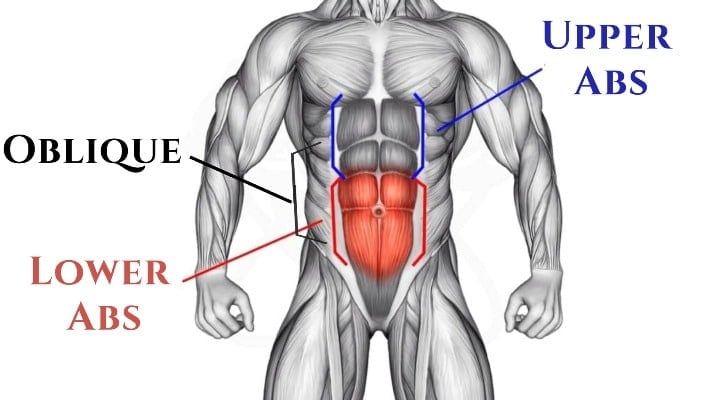
15 Best Exercises For The Upper Ab
Here are 15 excellent upper abs exercises and workouts to build an impressive six-pack.
Many exercises, such as crunches, sit-ups, planks, and v-ups, can be done at home without special gym equipment.
1. Knee Bent Sit-Ups
Sit Up is an excellent choice for creating muscular tension in your upper abs and help to strengthen your abs transverse abdominis, and obliques in addition to your hip flexors, chest, and neck.
They promote good posture by working your lower back and gluteal muscles.
This study has shown that the modified (knee-bent) sit-up focuses more on trunk flexion, better activates core muscles, and reduces potential strain on the lower back than a standard sit-up.
The sit-up is a classic best upper abs exercise that you can do at home. They use your body weight to strengthen and tone the core-stabilizing abdominal muscles.
- Level: Beginner
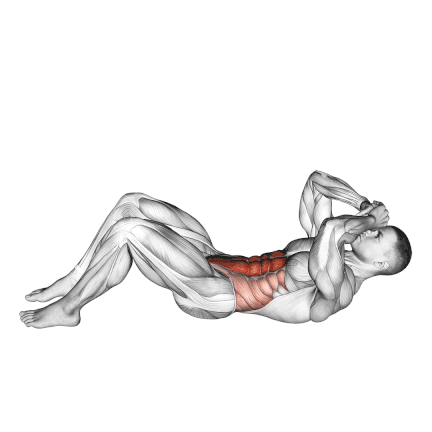
How To Do It
- Hook your feet under the pad and sit on the decline bench/floor with your torso upright.
- Place your hands behind your head. Don’t lean forward with your head. Keep a natural head position.
- Contract through your abs to lift your shoulders and upper back off the decline bench.
- Hold this position for a second before slowly lowering back to the starting position, making the negative portion of the rep as slow and deliberate as the positive portion.
- Repeat the desired number of reps.
2. Crunch
Crunches are another great exercise for your upper abs workout. The crunch motion occurs in the upper spine, and your shoulders rise a few inches off the floor.
Your lower back remains in contact with the floor, and the hips have no motion. This contrasts with the sit-up, where the movement occurs at the waist and hips.
You may position your hands at your sides or across your chest, or you may interlock them behind your head.
- Level: Beginner
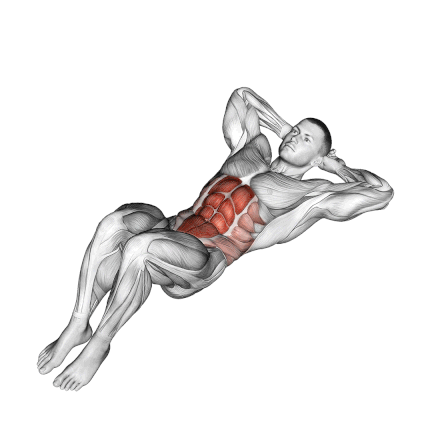
How To Do
- Lie on the floor with your knees bent and feet and lower back flat on the floor.
- Place your hands behind your head. Don’t pull on your neck with your hands; this will strain the neck.
- Brace your core. Crunch your ribs toward your pelvis, using your abdominal muscles to initiate and complete the movement.
- Hold this position for a second and then slowly return to the starting position (Do the negative part of the rep as slowly and carefully as the positive part).
- Keep the movement slow and controlled. Don’t use momentum.
Know More: Best Abs Exercises: Upper Abs, Lower Abs, Obliques
3. Bicycle Crunch
Unlike regular crunches, which mainly focus on your upper abs, the bicycle crunch engages both your upper and lower abs and also targets the obliques.
In a 2001 study by ACE, it was found that in compared to the standard crunch, the bicycle crunch produces 148% more mean activity in the abs and 190% more mean activity in the obliques.
You can kneel with a smaller angle to make it easier or a larger angle to make it harder.
- Level: Beginner and Intermediate
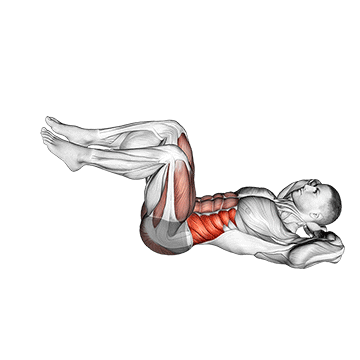
How To Do
- Lie on the floor with your legs straight and your lower back flat on the floor.
- Place your hands behind your head and raise your feet and upper back slightly off the floor.
- Slowly start raising your knees about a 45-degree angle.
- Go through a bicycle pedaling motion with your legs as you alternately touch your elbows to the opposite knees, twisting back and forth.
4. Cable Crunch
If you have access to a cable machine, this is a great way to add some variety and resistance to your core routine.
Cable crunches are a weighted crunch variation that targets your upper abs muscles. Doing crunches on a cable apparatus offers one huge advantage over doing them on the floor.
Unlike crunches on the floor, where gravity assists you, the cable provides constant resistance that forces your core muscles to work harder. This results in greater muscle activity and, ultimately, superior outcomes.
- Level: Intermediate and Advance
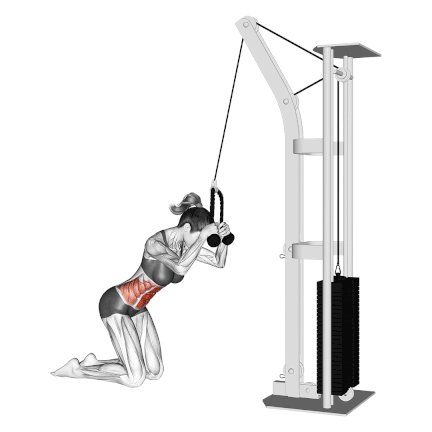
How To Do It
- Kneel in front of a high pulley. Take hold of the rope attachments with each hand and place your wrists against the sides of your head.
- Lower your torso by flexing your hips, but allow the rope’s weight to lift your upper torso to extend your lower back.
- Keep your hips fixed, and exhale as you pull the rope downward by flexing your abdomen so your back becomes arched.
- Hold for a count of two. Relax your abdomen and allow the rope to lift your upper torso to extend your lower back.
Know More: Most Effective Abs & Oblique Cable Exercises & Workout
5. Decline Sit-Ups
They are performed on a decline bench, where your head is lower than your feet. This angle increases the difficulty compared to flat sit-ups because you’re working against gravity more intensely.
They are also useful for advanced lifters who wish to load the exercise for greater progression.
- Level: Intermediate and Advance
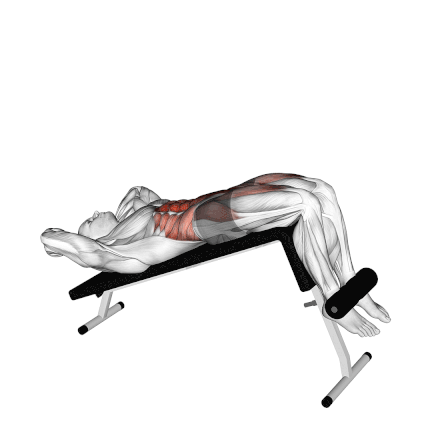
How To Do It
- Lie back on a decline bench with your feet secured under the foot pad.
- Place your hands behind your head or place them by your ears.
- Brace up the core and pull the chest towards their legs.
- Hold this position briefly before slowly lowering back to the starting position.
- Don’t allow any momentum to build up; keep the movement slow and under control.
6. Machine Crunch
This is a fantastic exercise if you’re looking for a way to add resistance and isolate your abdominal muscles and obliques. Effectively. Adding this movement to your workout will help you achieve great abs.
This is a convenient way to add resistance to your ab work for better abs development.
- Level: Intermediate and Advance
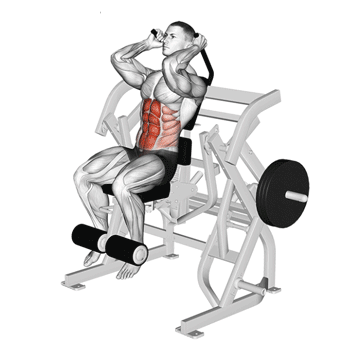
How To Do It
- Sit on the ab machine and select a slight resistance.
- Position your feet under the pads and hold the handles at the top.
- Make sure your arms are bent at 90 degrees.
- Keep your feet still and do crunches as instructed in the machine directions. Focus on contracting your ab muscles.
- Hold this position for a second before slowly lowering back to the starting position.
7. Decline Crunch
This variation of the classic crunch utilizes a decline bench to amp up the challenge and sculpt those abs.
A decline crunch bench positions your upper body at an angle so that it’s lower than your hips and thighs. This position causes your body to work harder, since you must work against gravity and through a wider range of motion.
- Level: Intermediate and Advance
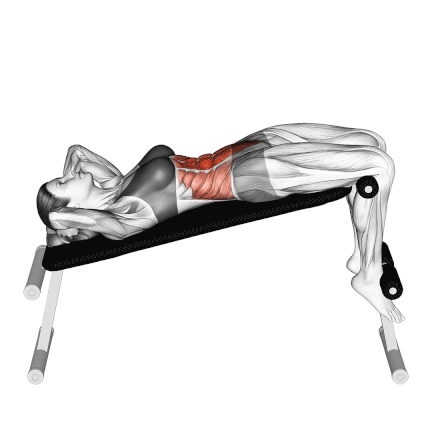
How To Do It
- Adjust the decline bench to a comfortable angle, typically between 15–30 degrees.
- Secure your feet under the padded rollers. Lie back on the bench with your head near the top.
- Place your hands lightly behind your head or cross them over your chest.
- Engage your core muscles and maintain a neutral spine.
- Exhale as you contract your abdominal muscles and curl your upper body towards your hips. Keep your neck relaxed and avoid pulling on your head.
- Reverse the motion and lower your torso to the starting position.
- Do 10-15 reps per set.
8. V-Up
The V-Up also known as a jackknife, is a full-body move that works your core, legs, back, and shoulders. The exercise works the upper and lower abs muscles simultaneously.
To do a V-Up, sit on the floor or a mat and lift both your arms and legs (like a letter V) using your abdominal muscles.
- Level: Intermediate and Advance
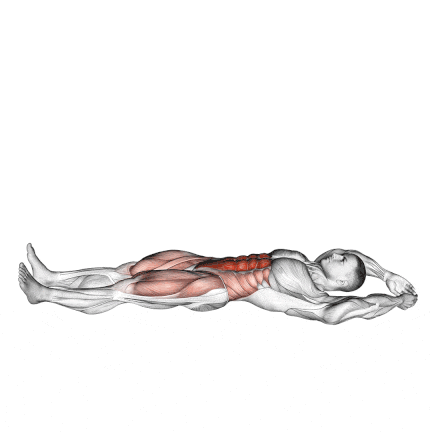
How To Do It
- Lie down on the floor on your back, arms extended straight back behind your head. Your legs should also be extended.
- Contract your abs and lift your upper body off the ground while raising your legs in a “V” shape.
- Extend your arms to your toes as you reach the top of the movement.
- Lower your arms and legs back to the starting position, inhaling as you do so.
9. Vertical Leg Crunch
If you are looking for another effective upper abs exercise, try the Vertical leg crunch. It is similar to the basic crunch, except that the legs are perpendicular to the floor.
This position increases the intensity of the exercise, so it is a good next step after you’ve mastered the basic crunch.
In one study, it was found that the vertical leg crunch produced 29% more mean activity in the rectus abdominis and 116% more mean activity in the obliques than the regular crunch.
- Level: Intermediate and Advance

How To Do It
- Lie supine (on your back) with your lower back pressed against the floor.
- Raise your arms and legs straight up into the air.
- Exhale as you slowly flex your abdomen and try to touch your toes with your fingers.
- Hold the contracted position for a count of two, and slowly return to the starting position.
- Hold a weight plate in your extended hands or behind your head to make the vertical leg crunch more difficult.
Read More To Know More: Best Dumbbell Abs Workout To Build Six Pack Abs
10. Abs Wheel Rollout
If you’re looking for a way to be more creative with your upper abs workout, try an Abs wheel rollout.
It strengthens the upper ab by lengthening them, which targets your eccentric strength. It is one of the more advanced exercises.
To build yourself up to it, you can start with the plank and graduate to the wheel rollout when ready. You can make the exercise easier by performing it up an inclined surface.
They’re also excellent conditioning exercises for athletes. This ab wheel workout can be done at home or in gyms.
- Level: Intermediate and Advance
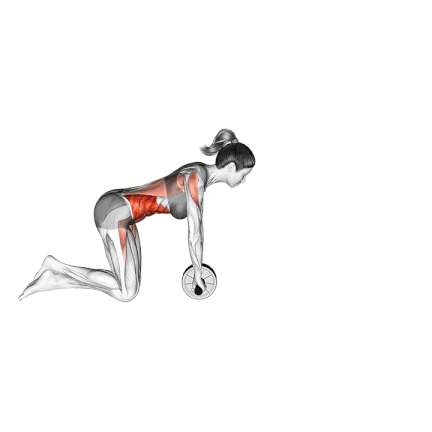
How To Do It
- Kneel on the floor and grasp the ab wheel roller with your hands.
- Allow the abs wheel to roll forward as far as possible, with just your knees and toes touching the floor, while maintaining your grip.
- In the finish position, the goal is to be as flat as possible, with your torso and upper legs parallel to the floor and hovering just a couple of inches above it.
- Or Move within a comfortable range of motion. You should not strain your lower back.
- Then, reverse the motion to pull the abs wheel back toward your knees until your body is upright again.
- Do as many reps as you can.
11. Stability Ball Forearm Plank
The stability ball adds an element of instability that forces your core muscles to work harder to keep balance.
It is a challenging and effective core body exercise that forces you to pull your abs in, tighten your glutes, and squeeze your legs to hold your body straight.
- Level: Intermediate To Advanced
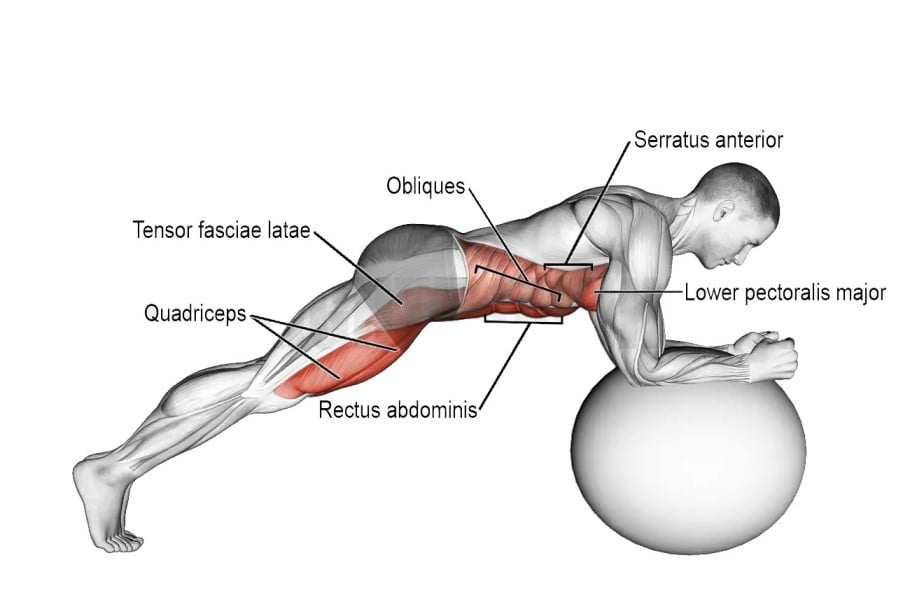
How To Do it
- Get into a straight body position from your head to your heels.
- Place your forearms on the stability ball and feet on the floor; maintain a straight body position from your head to your heels.
- Stack your shoulders directly over your elbows, and press your forearms into the stability ball to support your shoulders.
- Maintain a tight core while squeezing through your quads and chest.
- Hold this position for a set amount of time.
Know More: Plank Exercise: Benefits, Variations, Muscles Worked, Tips
12. Elbow To Knee Side Plank Crunch
The Elbow Knee Side Plank Crunch is a brilliant bodyweight exercise that helps you to develop the strength and stability of your upper abs and oblique.
Combine your standard crunches with side plank exercise into one move that will challenge your balance, tone up your waist, and strengthen your core.
- Level: Intermediate and Advance

How To Do It
- Get in a side plank position by lying on your right side on the floor. Your left foot should rest on top of the inner side of your right foot, and your left arm should rest on top of your left side.
- Raise your body by placing your right forearm flat on the floor to be perpendicular to your torso.
- Lift your torso until your right upper arm is straight underneath you, with your elbow bent 90 degrees and your forearm flat on the floor. Extend your left arm over your head.
- Lift your left leg and drive your knee toward your torso.
- At the same time, bring your left arm toward your knee in a crunch movement.
- Continue for a set amount of time, and then repeat on the other side.
13. Hollow Hold
The hollow holds are like upside-down planks. You position yourself on your buttocks, with your legs and arms extended, to increase your center of mass.
Your upper abs are at your center, working hard to keep you upright. This move is highly effective and requires little space and no equipment.
- Level: Beginner and Intermediate

How To Do It
- Lie down on your back and extend your arms above your head so your biceps are next to your ears.
- Brace your core by drawing your ribs toward your pelvis and flexing your abs.
- Lift your feet, legs, shoulders, and arms off of the floor and press your lower back into the ground.
- The only place you should touch the floor is your lumbar spine.
- Hold the pose for a few seconds, working up to longer holds as you get stronger.
14. Inchworm
The inchworm combines dynamic stretching with cardio. It targets multiple muscle groups, including your shoulders, core, hamstrings, and calves. Plus, it’s a great way to loosen up your spine and improve your overall mobility.
This full-body movement is an effective exercise to include in your warm-up routine or training circuit.
- Level: Beginner and Intermediate
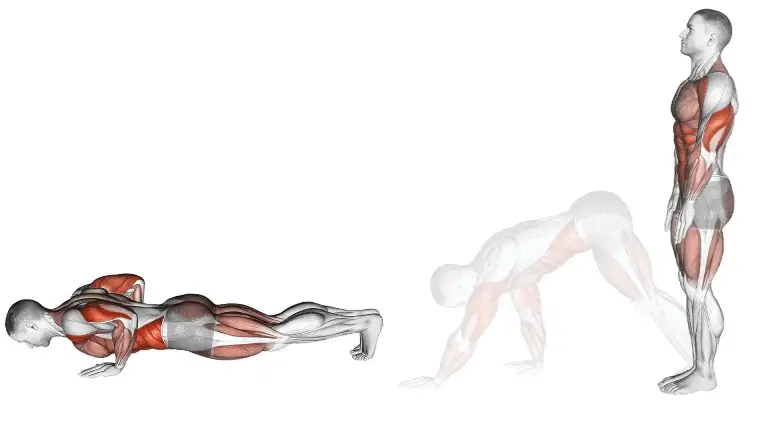
How To Do It
- Position yourself at the back of the mat with your feet hip-width apart and your arms by your sides.
- Slowly bend over until both hands touch the floor in front of the feet.
- Keeping legs as straight as possible and core tight, walk hands forward into a plank position.
- Hold for a moment, then slowly reverse the movement to return to start. That’s one rep.
- Complete as many reps as possible in 20–30 seconds.
15. Plank To Toe Touch
The plank-to-toe touch is a variation of the traditional plank exercise that adds extra difficulty and engagement for your core and upper ab muscles.
This is a great move to add to your warmup on upper body days since it helps increase blood flow, warms the body, activates the core, mobilizes the shoulders, and stretches the hamstrings.
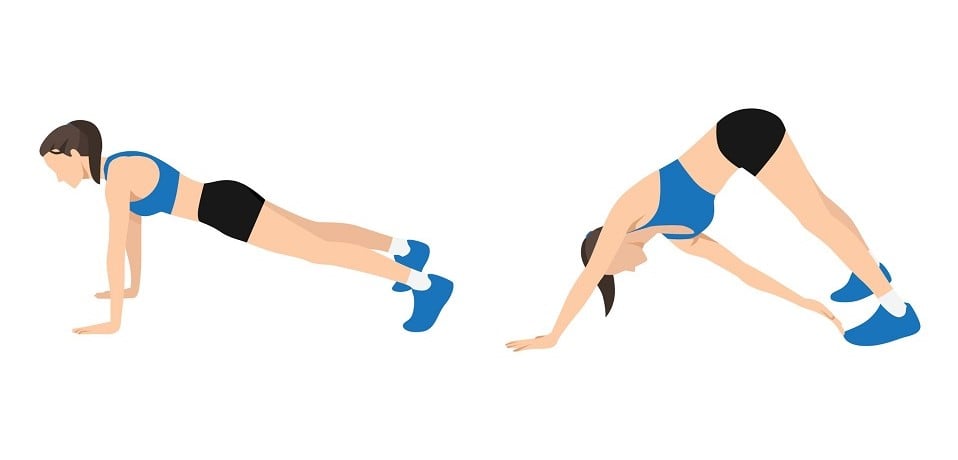
How To Do It
- Start in a high plank position
- Push your hips up high
- Keep your legs straight
- Take your right hand and reach for your left toe
- Return to the high plank position
- Take your left hand and reach for your right toe
- Complete 3-4 sets of 10-15 reps on each side
Upper Ab Training Tips and Workout Routines
If your upper abs are lagging and you really want to build impressive six-pack abs, you can prioritize them, but still don’t forget about your lower abs and oblique muscles.
Below, I have listed sample workouts for beginner, intermediate, and advanced levels. I’ve also provided the number of sets and reps you should aim for.
Beginner-level Upper Ab Workout
If you’re new to lifting weights, don’t worry. This beginner-friendly abs workout routine is a great place to start.
| Exercise | Sets | Reps |
|---|---|---|
| Sit-Ups | 4 | 8-10 |
| Crunches: | 4 | 12-15 |
| Bicycle Crunch: | 3 | 8-12 |
Intermediate
If you are at the intermediate level or have outgrown the beginner routine, try the intermediate abs workout routine below.
| Exercise | Sets | Reps |
|---|---|---|
| V-Up | 4 | 10-12 |
| Bicycle Crunch | 4 | 8-10 |
| Seated Knee Up | 3 | 8-12 |
| Decline Crunch | 3 | 8-10 |
Advanced
Here, you’ll challenge your balance, stability, and strength more.
| Exercise | Sets | Reps |
|---|---|---|
| Cable Crunch | 3-4 | 8-10 |
| Twisting Sit-Up | 3-4 | 8-12 |
| Vertical Leg Crunch | 3 | 10-12 |
| Abs Wheel Rollout | 3 | 8-10 |
FAQs
What is the best exercise for upper abs?
Here are the best upper abs exercises to build impressive six-pack abs and a stronger core.
- Sit-Ups
- Crunches
- Bicycle Crunch
- Seated Knee Up
- Cable Crunch
- Twisting Sit-Up
- V-Up
- Vertical Leg Crunch
- Abs Wheel Rollout
Do planks work upper abs?
Yes, a plank is an excellent exercise for developing a strong core, including your upper and lower abs. It s one of the brilliant bodyweight abs exercises you can add to your home workout regime. It helps you develop the strength and stability of your core.
Can you target upper abs?
When attempting to target the upper abs, it is important to remember that there is no true isolation exercise for any of the abdominal muscles. However, if you want to specifically target your upper abs, you can focus on movements that involve pulling your chest toward your pelvis.
Do crunches work upper abs?
Crunches and sit-ups are both excellent exercises for working the upper abs. They provide intense muscle isolation, making them popular with people who want six-pack abs.
How Often Should You Train the Upper Abs?
Most beginners will notice an improvement in their abdominal muscles after training them directly two to three days per week. Since many strength movements involve the core and upper abdominal muscles.
How to get rid of upper belly fat?
A diet is the most important thing for getting rid of upper belly fat. Cardio and exercises alone will not burn fat.
How can I build my upper abs at home?
To build a solid core and chiseled upper abs at home without any special equipment, you must add crunches, sit-ups, planks, and v-ups to your abs workout regime. With such a variety, it’s easy to develop a great upper ab routine to go through a few times a week.
References
- Phys Ther. 2000 Jun;80(6):564-9. Abdominal muscle response during curl-ups on both stable and labile surfaces. Vera-Garcia FJ1, Grenier SG, McGill SM.
- Sullivan W, Gardin FA, Bellon CR, et al. (2015) Effect of traditional vs. modified bent-knee sit-up on abdominal and hip flexor muscle electromyographic activity. J Strength Cond Res 29: 3472-3479.
- Hildenbrand K, Noble L. Abdominal Muscle Activity While Performing Trunk-Flexion Exercises Using the Ab Roller, ABslide, FitBall, and Conventionally Performed Trunk Curls. J Athl Train. 2004;39(1):37-43.
- Tremblay A, Simoneau J-A, Bouchard C. Impact of exercise intensity on body fatness and skeletal muscle metabolism. Metabolism. 1994;43(7):814–818
- Norris, C M (March 1993). “Abdominal muscle training in sport”. British Journal of Sports Medicine. 27 (1): 19–27. doi:10.1136/bjsm.27.1.19. ISSN 030 6-3674. PMC 133 2101. PMID 8457 806.

Manish is a NASM-certified fitness and nutrition coach with over 10 years of experience in weight lifting and fat loss fitness coaching. He specializes in gym-based training and has a lot of knowledge about exercise, lifting technique, biomechanics, and more.
Through “Fit Life Regime,” he generously shares the insights he’s gained over a decade in the field. His goal is to equip others with the knowledge to start their own fitness journey.

